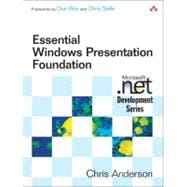
What is included with this book?
Chris Anderson, architect in Microsoft’s Connected Systems Division, specializes in designing and architecting .NET technologies for the next generation of applications and services. In ten years at Microsoft, he has worked on technologies ranging from Visual Basic 6.0 and Visual J++ 6.0 to .NET Framework 1.0 and 1.1. In 2002, he joined the Windows Client team as an architect for Windows Presentation Foundation. Anderson has spoken at numerous conferences, including PDC, TechEd, WinDev, and DevCon.
| Figures | p. xv |
| Foreword by Don Box | p. xxv |
| Foreword by Chris Sells | p. xxvii |
| Preface | p. xxix |
| About the Author | p. xxxix |
| Introduction | p. 1 |
| WPF as the New GUI | p. 1 |
| A Brief Look at the XAML Programming Model | p. 11 |
| A Tour of WPF | p. 17 |
| Tools for Building Applications | p. 39 |
| Where Are We? | p. 41 |
| Applications | p. 43 |
| Application Principles | p. 43 |
| Application | p. 52 |
| Resources and Configuration | p. 60 |
| Windows | p. 71 |
| User Controls | p. 80 |
| Navigation and Pages | p. 83 |
| Hosting Applications in a Browser | p. 103 |
| Where Are We? | p. 111 |
| Controls | p. 113 |
| Control Principles | p. 113 |
| Control Library | p. 128 |
| Building Blocks | p. 161 |
| Where Are We? | p. 171 |
| Layout | p. 173 |
| Layout Principles | p. 173 |
| Layout Library | p. 186 |
| Grid | p. 196 |
| Writing a Custom Layout | p. 207 |
| Where Are We? | p. 215 |
| Visuals | p. 217 |
| 2D Graphics | p. 218 |
| 3D Graphics | p. 254 |
| Documents and Text | p. 267 |
| Animation | p. 283 |
| Media | p. 300 |
| Where Are We? | p. 305 |
| Data | p. 307 |
| Data Principles | p. 307 |
| Resources | p. 310 |
| Binding Basics | p. 316 |
| Binding to CLR Objects | p. 322 |
| Binding to XML | p. 331 |
| Data Templates | p. 338 |
| Advanced Binding | p. 342 |
| Data-Driven Display | p. 357 |
| Where Are We? | p. 363 |
| Actions | p. 365 |
| Action Principlesv365 | |
| Events | p. 369 |
| Commands | p. 373 |
| Triggers | p. 383 |
| Where Are We? | p. 389 |
| Styles | p. 391 |
| Style Principles | p. 391 |
| Beginning Styles | p. 397 |
| Using Styles for Good, Not Evil | p. 415 |
| Where Are We? | p. 419 |
| Appendix: Base Services | p. 421 |
| Threading and Dispatchers | p. 421 |
| Properties | p. 427 |
| Keyboards, Mice, and Styluses | p. 437 |
| Where Are We? | p. 442 |
| Index | p. 443 |
| Table of Contents provided by Publisher. All Rights Reserved. |
The New copy of this book will include any supplemental materials advertised. Please check the title of the book to determine if it should include any access cards, study guides, lab manuals, CDs, etc.
The Used, Rental and eBook copies of this book are not guaranteed to include any supplemental materials. Typically, only the book itself is included. This is true even if the title states it includes any access cards, study guides, lab manuals, CDs, etc.